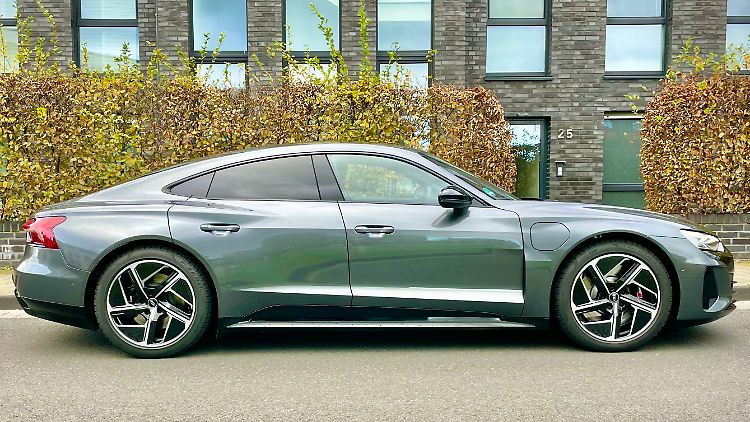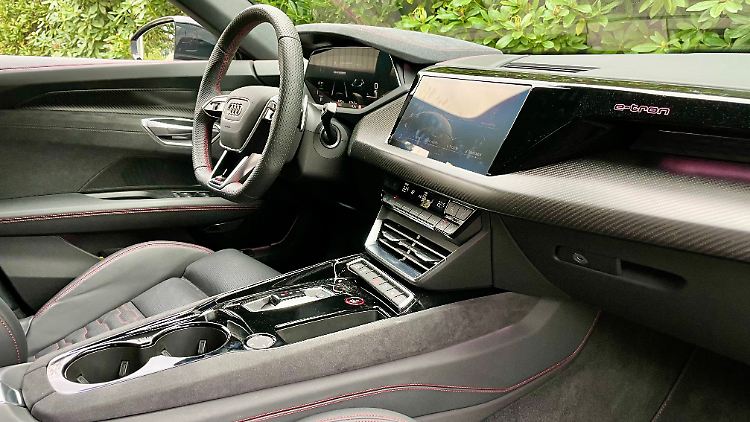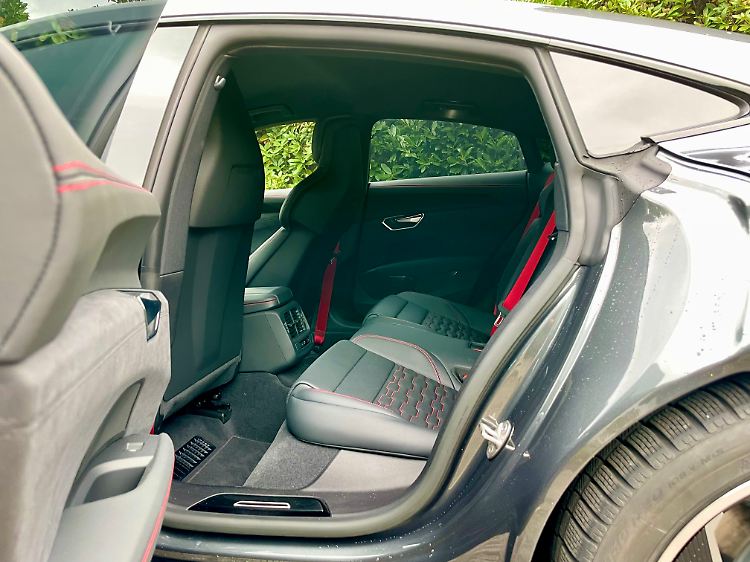With the E-Tron GT, Audi was early on in the field of electrically powered mobility. How is the sedan doing after almost half a decade of construction? ntv.de has subjected the Ingolstadt model to a practical test – as a more powerful RS variant.
Cars that have just appeared on the market always have two sides. Sure, they’re attractive because you have the latest model under your belt. On the other hand, cars that have been built for a long time are considered more sophisticated. Now the standards for electrically powered cars are different anyway, because the technological leaps to be expected here are much larger, especially with regard to the issues of batteries and charging performance. In this regard, Audi did a pretty good job four years ago with the E-Tron GT. It’s important to get to the bottom of this.


Flat and stretched is still beautiful: the Ingolstadt resident generally hardly holds back when it comes to visual appeal.
(Photo: Patrick Broich)
But first the four-door car is inspected. And what catches the eye is that, on the one hand, he looks really smart and full. On the other hand, there is nothing wrong with RS tinsel. Of course, it doesn’t need the thick stovepipes of a combustion engine RS because of its drive. Nevertheless, the design team could have worked hard to make the most powerful E-Tron look extroverted. So even more extroverted. Just like you imagine a real RS car to be. But no. The silent Power GT is a picture-perfect beau, but it’s definitely more elegant than flashy, even though the technicians won’t let it hit the road without a rear diffuser. On top there is the small RS logo. That’s it.
The E-Tron GT can be attractive for company car drivers


Well-shaped sports seats not only keep the passengers firmly in the middle, but are also comfortable. It’s nice that the air conditioning is operated using separate, physical buttons.
(Photo: Patrick Broich)
And inside? Technically cool and sporty (with a lot of touchscreen), but with typical Audi precision workmanship, the flat E-Tron delivers what its customers can expect, including plenty of space at the front and rear – especially at the not entirely trivial price of 145,500 euros. At best, a certain group of company car drivers is likely to rub their hands. This is when the employer takes care of the purchase (possibly at a well-negotiated leasing rate). As is well known, the flat rate tax borne by the user is only levied on the basis of the halved gross list price.
And how good that this J1 representative (the name of the platform on which the Porsche Taycan is based) is an Audi. Because the envy factor isn’t quite as noticeable here as it is with the models from Zuffenhausen. But since it is based on the same genetics as the Taycan, the Ingolstadt vehicle is also beyond any doubt in terms of driving dynamics. For reasons of respect, the Upper Bavarian gets “only” 646 hp, while the Stuttgarter can sprint off with 761 hp. Ha! Now don’t think that 646 horses (830 Newton meters) worth of boost punch wouldn’t make for sagging stomachs. Although the permanently excited synchronous motors reduce to 598 hp after just a few seconds, the speed is then almost 100 (3.3 seconds).


The E-Tron GT doesn’t skimp on knee room in the second row.
(Photo: Patrick Broich)
A small flaw is that, depending on the circumstances, the GT’s automatic two-speed transmission takes away the spontaneity that is actually typical of electric drives. It’s not a moment of reflection that some powerful combustion engines need before they bite again after a gear change. But the interruption in traction can last for a tenth of a second. It doesn’t sound like much, but it’s noticeable and sometimes annoying. But then the athlete pushes hard up to the limited speed of 250 km/h.
Packed with chassis technology
It is obvious that the engineers have also made the 2.4-ton truck more cross-performing. It’s not just the low center of gravity that helps, but also the technical equipment. Such as the all-wheel steering, which is available for an additional charge of 1,390 euros. With this, the Ingolstadt native should be able to corner even more dynamically. If desired, it actually does this pretty quickly, although the precise steering also plays its part. The powerful electric motors help to maximize the fun on the winding country road, namely when accelerating powerfully out of bends.


Rear lights that take some getting used to hardly detract from the attractiveness of this coupe-like sedan.
(Photo: Patrick Broich)
In order to achieve maximum traction, Audi installed an electronically controlled, mechanical rear axle locking differential with a multi-plate clutch in the RS version in order to nip slip on the rear wheels in the bud. In order to slow down the speed again, recuperation is primarily used, in which kinetic energy is converted back into electrical power at up to 265 kilowatts. If the deceleration is not sufficient, the system switches to friction brakes without the driver having to do anything. And if you want to push the GT really hard (for example on the track), you can get maximum-stable ceramic discs for 5,600 euros.
But precise steering, brutal thrust – can the E-Tron GT be as emotional as a roaring RS6? At least the sound component is missing. But there is artificially generated sound. But seriously, I’ll turn it off as quickly as possible. Yes, the E-Tron GT is somehow emotional – but the sound component is somehow sorely missing. Don’t do anything. Although, yes. Simply enjoy the tourer on long journeys, which it takes quite calmly for various reasons. Because thanks to its impressive 2.90 meter wheelbase, the 4.99 meter liner skilfully smooths undulating highways.
The E-Tron GT is suitable for long distances


350 liters of trunk volume is a bit meager for a full-sized business sedan.
(Photo: Patrick Broich)
But there is another little thing that concerns many people when it comes to battery-electric cars – especially when it comes to long-distance travel. And here Audi has really done a great job: The E-Tron GT is one of the early examples with an 800-volt electrical system. Nominally, it draws up to 270 kilowatts of electricity. That’s damn fast. Of course, ntv.de tried out some 300 kilowatt columns and did the test. If the battery is almost empty and at a good temperature, it even works with fast charging. So I start at six percent state of start and 21 kilometers remaining range. After five minutes I look at the display and the Audi has a respectable 249 kilowatts of charging power. Twenty minutes later, the range has increased from 21 to 300 kilometers, but now the charging power has dropped to 118 kilowatts and the charge level is now 76 percent.
Everyone can decide for themselves whether this is practical or not – but with this performance the expensive Audi still beats many (newer) competitors even in expensive segments. On the other hand, it must also be said that the two synchronous machines do not work particularly efficiently. The data sheet shows 19.8 to 22.1 kWh consumption per 100 kilometers. As a result, the battery with a net capacity of 83.7 kWh is said to have emptied after at best 496 kilometers. More must be possible in this league today. And if you take advantage of the power, you can also have 30 kWh on the clock. Good for anyone who owns a photovoltaic system on the roof. Otherwise, feeding the E-Tron GT will be expensive. But it’s an expensive pleasure anyway. Albeit a pleasure.
Audi E-Tron GT RS data sheet
|
Dimensions (length/width/height) |
4.99 / 1.96 / 1.41 m |
|
wheelbase |
2.90 m |
|
Empty weight (DIN) |
2420kg |
|
Seating |
5 |
|
loading volume |
350 liters plus 81 liters (Frunk) |
|
Engine type |
Two synchronous motors, permanently excited |
|
transmission |
Two-speed automatic transmission |
|
Power, electric motor at the front |
238 hp (175 kW) |
|
Performance, rear electric motor |
456 hp (335 kW) |
|
System performance |
646 hp (475 kW) |
|
drive |
all wheel drive |
|
Max. Torque |
830 Nm |
|
Acceleration 0-100 km/h |
3.3 seconds |
|
Top speed |
250 km/h |
|
Battery capacity |
84 kWh (net) |
|
Maximum charging power (direct current) |
270kW |
|
Charging power (alternating current) |
11 to 22 kW |
|
Consumption (combined) |
19.8 to 22.1 kWh/100 km (WLTP) |
|
combined WLTP range |
447 to 496 kilometers |
|
Combined CO₂ emissions |
0g/km |
|
Basic price |
From 145,500 euros |
Conclusion: After four years of construction, the Audi E-Tron GT is still up to date. This is not least because it was ahead of its time when it was released – especially in terms of charging performance. When it comes to infotainment, the sedan is state of the art with an optional head-up display and large touchscreen. In addition, the extremely powerful tourer is quite comfortable despite its dynamic capabilities and is therefore ideal as a touring car. However, Audi has to improve its efficiency. The same applies to the amount of electricity that can be stored.
































